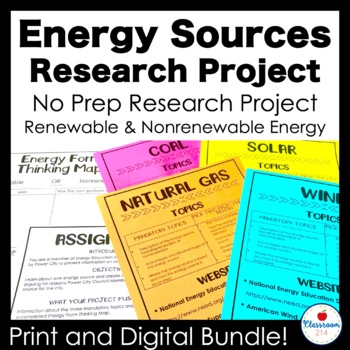Renewable and Nonrenewable Energy Activity
- PDF
- Google Apps™

What educators are saying
Also included in
- Two dynamic renewable and nonrenewable energy sources projects. Student will apply research skills to learn about renewable and nonrenewable energy sources and then apply their knowledge to help a fictional community decide which two energy sources are best for their town. These projects put studenPrice $5.20Original Price $6.50Save $1.30
Description
This ready to use renewable and nonrenewable energy sources research project will help your students master energy sources. Each assignment card includes 3 websites students can use right away. The digital version includes live links. The graphic organizer and rubric will help them stay focused. A No Prep! Assign and Go! research project.
Includes the following energy sources:
RENEWABLE
- Biomass
- Geothermal
- Hydropower
- Solar
- Wind
NONRENEWABLE
- Coal
- Natural Gas
- Petroleum
- Propane
- Uranium
Divide the set and have students focus on one energy source and teach their classmates, or use them for a summative project and have students persuade a panel of city council members that their energy source is the best one for powering the city.
WHAT'S INCLUDED (PRINT AND DIGITAL VERSION OF EVERYTHING LISTED)
- Assignment cards for each energy source
- 3 website per energy source
- Group Roles to help students equitably divide the responsibilities
- Energy Form Thinking Map (a note taking graphic organizer)
- Rubrics
- Teacher background information and directions
Best of all, this project can be completed with minimal teacher prep! You need to provide the print resources for research and/or access to computers with internet access if you want students to complete the research during class time. Otherwise, students only need to have access to resources to create their presentations (Power Point, Prezie, poster board, etc.).
This is an dynamic project with the built-in flexibility to be a teaching tool or a summative project.
If you choose to use this as a teaching tool, you’ll want to check out The Renewable and Nonrenewable Energy Summative Project for an exciting way to close out your energy unit!
Created by Classroom 214
Follow my store to hear about new products and sales. New resources are 50% off for the first 24 hours.






